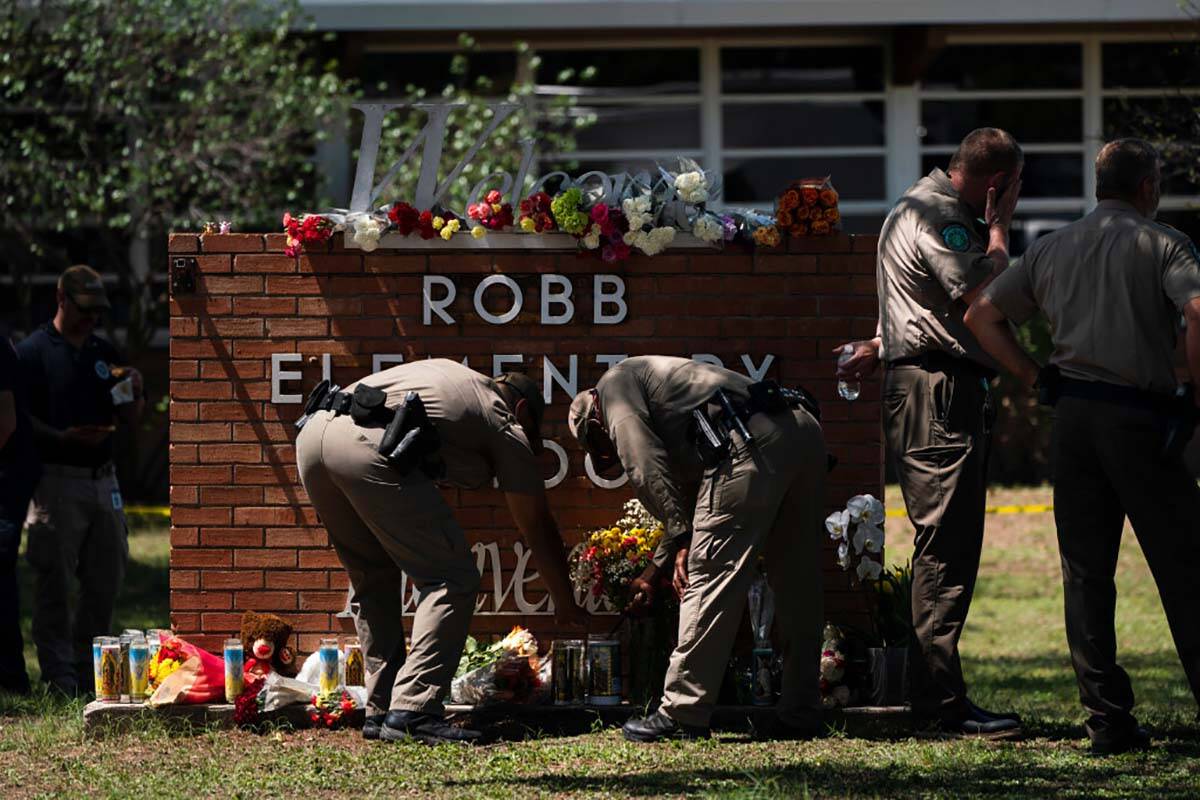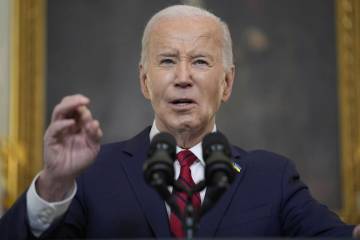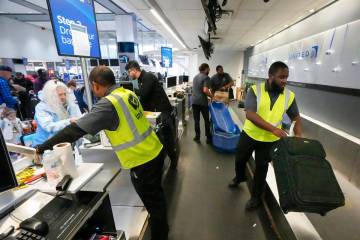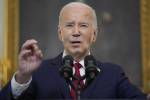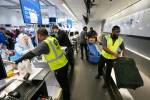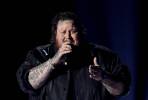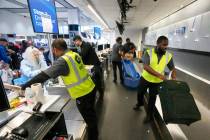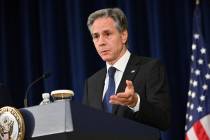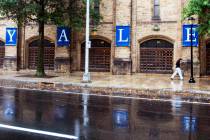Texas gunman was inside the school for over an hour, police say
UVALDE, Texas — It was 11:28 a.m. when the Ford pickup slammed into a ditch behind the low-slung Texas school and the driver jumped out carrying an AR-15-style rifle.
Twelve minutes after that, authorities say, 18-year-old Salvador Ramos was in the hallways of Robb Elementary School. Soon he entered a fourth-grade classroom. And there, he killed 19 schoolchildren and two teachers in a still-unexplained spasm of violence.
At 12:58 p.m., law enforcement radio chatter said Ramos had been killed and the siege was over.
What happened in those 90 minutes, in a working-class neighborhood near the edge of the little town of Uvalde, has fueled mounting public anger and scrutiny over law enforcement’s response to Tuesday’s rampage.
“They say they rushed in,” said Javier Cazares, whose fourth-grade daughter, Jacklyn Cazares, was killed in the attack. He raced to the school as the massacre unfolded. “We didn’t see that.”
On Thursday, authorities largely ignored questions about why officers had not been able to stop the shooter sooner, with Victor Escalon, regional director for the Texas Department of Public Safety, telling reporters he had “taken all those questions into consideration” and would offer updates later.
The media briefing, called by Texas safety officials to clarify the timeline of the attack, provided bits of previously unknown information. But by the time it ended, it had added to the troubling questions surrounding the attack, including about the time it took police to reach the scene and confront the gunman, and the apparent failure to lock a school door he entered.
No district officer in school
After two days of providing often conflicting information, investigators said that a school district police officer was not inside the school when Ramos arrived, and, contrary to their previous reports, the officer had not confronted Ramos outside the building.
Instead, they sketched out a timeline notable for unexplained delays by law enforcement.
After crashing his truck, Ramos fired on two people coming out of a nearby funeral home, Escalon said. He then entered the school “unobstructed” through an apparently unlocked door at about 11:40 a.m.
But the first police officers did not arrive on the scene until 12 minutes after the crash and and did not enter the school to pursue the shooter until four minutes after that. Inside, they were driven back by gunfire from Ramos and took cover, Escalon said.
The crisis came to an end after a group of Border Patrol tactical officers entered the school roughly an hour later, at 12:45 p.m., said Texas Department of Public Safety spokesperson Travis Considine. They engaged in a shootout with the gunman, who was holed up in the fourth-grade classroom. Moments before 1 p.m., he was dead.
Escalon said that during that time, the officers called for backup, negotiators and tactical teams, while evacuating students and teachers.
Many other details of the case and the response remained murky. The motive for the massacre — the nation’s deadliest school shooting since Newtown, Connecticut, almost a decade ago — remained under investigation, with authorities saying Ramos had no known criminal or mental health history.
Frustrated onlookers urged police to act
During the siege, frustrated onlookers urged police officers to charge into the school, according to witnesses.
“Go in there! Go in there!” women shouted at the officers soon after the attack began, said Juan Carranza, 24, who watched the scene from outside a house across the street.
Carranza said the officers should have entered the school sooner: “There were more of them. There was just one of him.”
Border Patrol Chief Raul Ortiz did not give a timeline but said repeatedly that the tactical officers from his agency who arrived at the school did not hesitate. He said they moved rapidly to enter the building, lining up in a “stack” behind an agent holding up a shield.
“What we wanted to make sure is to act quickly, act swiftly, and that’s exactly what those agents did,” Ortiz told Fox News.
But a law enforcement official said that once in the building, the agents had trouble breaching the classroom door and had to get a staff member to open the room with a key. The official spoke on condition of anonymity because he was not authorized to talk publicly about the investigation.
Department of Public Safety spokesman Lt. Christopher Olivarez told CNN that investigators were trying to establish whether the classroom was, in fact, locked or barricaded in some way.
Husband of slain teacher dies of heart attack
Irma Garcia’s family was already reeling from her death in the Texas school shooting that targeted her fourth grade classroom and killed her co-teacher and 19 students.
Then, a mere two days after the attack, her grieving husband collapsed and died at home from a heart attack, a family member said.
Joe Garcia, 50, dropped off flowers at his wife’s memorial Thursday morning in Uvalde, Texas, and returned home, where he “pretty much just fell over” and died, his nephew John Martinez told The New York Times.
Married for 24 years, the couple had four children.
Martinez told The Detroit Free Press that the family was struggling to grasp that while the couple’s oldest son trained for combat in the Marine Corps, it was his mother who was shot to death.
“Stuff like this should not be happening in schools,” he told the newspaper.
The Archdiocese of San Antonio and the Rushing-Estes-Knowles Mortuary confirmed Joe Garcia’s death to The Associated Press. AP was unable to independently reach members of the Garcia family on Thursday.
Congress focus
A bipartisan group of senators is considering how Congress should respond to the horrific shooting of 19 children and two teachers in Texas, restarting gun control talks that have broken down many times before.
Aware of the difficulty of their task, the Democrats and Republicans say they hope to find agreement on legislation that could help reduce the number of mass shootings in the United States. The Uvalde shooting came 10 days after a gunman opened fire in a racist attack killing Black people at a Buffalo, N.Y. supermarket.
Senators have narrowed the discussion to a few ideas, many of them based on legislation they have been working on for years, such as expanded background checks or red flag laws that keep guns away from people who could do harm. Led by Democratic Sen. Chris Murphy of Connecticut, the group of 10 is hoping to negotiate a proposal over the Senate’s upcoming recess and have it ready for a vote at the beginning of June.
It is uncertain if the group can come to consensus, and even if they do, winning enough votes from Republicans could prove difficult, as most do not want to see changes in the nation’s gun laws. Democrats would need 10 Republican votes to overcome a filibuster and get a bill through the 50-50 Senate.
“Odds are against us, but we owe it to parents and kids to try,” tweeted Murphy, who has been a lead advocate for stricter gun control since 20 children and six educators were killed at Sandy Hook Elementary School in Newtown, Conn. in 2012.
NRA convention opens
The National Rifle Association begins its annual convention in Houston on Friday, and leaders of the powerful gun-rights lobbying group are gearing up to “reflect on” — and deflect any blame for — the deadly shooting earlier this week of 19 children and two teachers at an elementary school in Texas.
Former President Donald Trump and other leading Republicans are scheduled to address the three-day firearms marketing and advocacy event, which is expected to draw protesters fed up with gun violence.
Some scheduled speakers and performers have backed out, including two Texas lawmakers and “American Pie” singer Don McLean, who said “it would be disrespectful” to go ahead with his act in the aftermath of the country’s latest mass shooting.
While President Joe Biden and Democrats in Congress have renewed calls for stricter gun laws, NRA board member Phil Journey said the focus should be on better mental health care and trying to prevent gun violence. He said he wouldn’t support banning or limiting access to firearms



